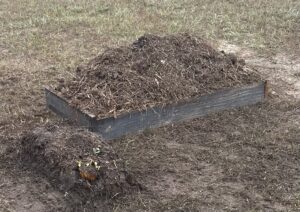NO HORSE SHOULD BE THROWN OUT LIKE WASTE!
ROUGH DRAFT:
“You don’t throw a whole life away just because he’s banged-up a little.”
New Careers for OTBs:
[Develop a Name for our Organization. Designate what type of corporation it is.]
We establish new jobs and careers for Retired Racehorses on our farm where we use the manure and materials to create soil!

Creating Gardening Soil:
From Poop To Plate
We view poop, not as waste, but as a commodity (soil,)!
We educate younger generations, by example, how to create their own soil to grow food out of!
There is nothing more self-satisfying than eating a salad which is, “farm-to-plate-fresh,” grown from start to finish in your own backyard by you and your own family!
…
Notes:
Showing ALL of the steps of the process, specifically, the finished product, (food,) is integrally necessary for the program’s success.
This is a concept of, “The One Man Project”.
Off the track thoroughbreds are thrown away like waste.
Please, emails any ideas to:
LonesomeGloryPublicationsLegal@gmail.com
The Warriors’ Garden
Operation Loin Cloth Ministry’s Compost Project
I built a frame using broken fence boards and filled it with horse manure, cow manure, dog poop, bat guano, grass clippings, eggshells, coffee grinds, a lot of ash, food scraps, tissues, paper products, leaves and (some) sand.

As I filled it, I added water and leveled it until the mixture had reached the top.
I built more frames and stacked them as I continued to fill, water, level and repeat.

After a couple days of watering, aerating (using a pitchfork,) and allowing the compost pile to bake in the sun, I removed the wood frame, relocated it, then, flipped the compost pile into the frame in it’s new location.

I repeated this, “Flipping Process.” two more times over the next nine days.
I, then, removed the wood frames by lifting them up and over the pile and used them to create raised garden beds.

After letting the compost pile sit exposed to the sun and the wind for two days, I built a slightly larger compost box and flipped the compost in to it, mixing-in more (a Lot of,) ash.


The next step in the composting process is to allow it to soak in the sun for a minimum of 33 days. At that moment in time, the compost will be ready for a final flip, ensuring a uniform moisture content level; or it may be used as gardening soil, ready to go!
In the beginning of that 33 day period, the nitrogen content of the pile should be relatively high in comparison to the soil of the earth or in potting soil. This high nitrogen content aids in raising the pile’s temperature, in concert with anaerobic activity.
This raising in temperature is key to the composting process. If you ever see steam coming off of your compost pile early in the morning, you know that you are on the road paved with Black Gold!
Anaerobic Activity:
It is important to be mindful of the anaerobic activity within the pile which is the result of many factors, including compression from the weight, material porousness, along with the sealing affect which water creates.
Aerating the pile as you fill it, and on a regulated basis as time passes, is essential to utilizing that anaerobic activity to the fullest!
- Anaerobic activity is a key component to composting;
- however, when that activity becomes septic, it is no longer an asset, but a crippling liability! … it will ruin all the effort and time employed!

Visit Our Growing Pumpkins Page!
Now, time to let this box sit and begin building another one. It is optimal to have at least three of these piles going at once. That way, you have one pile to plant with in the spring through the middle of summer. You have one box for late summer through fall, and the third box is one you let sit the longest for next spring’s planting. As you use the material from bins one and two, begin the process over with those, so that you have a perpetual cycle going. That way, in two years’ time, pile number three will have been composting for over twelve months before being used and, therefore, will be some powerful, black gold!
Chip Van Hassel
Lonesome Glory Publications.


